VANCOUVER, BC October 3, 2022 – CopperCorp Resources Inc. (TSXV: CPER) (OTCQB: CPCPF) (“CopperCorp” or the “Company”) is pleased to report new assay results from seven diamond drill holes at the Alpine prospect, part of its 100%-owned, approximately 1,066km2 AMC Copper Project located in the 100% renewable energy state of Tasmania, Australia.
Highlights
- Significant mineralized intercepts from the recently received drill core assays include:
| Hole ID | Interval (m)1 | From (m) | Cu (%) | Co (ppm) |
| AP030 | 26.2 | 85.8 | 0.53 | 191 |
| And | 37.0 | 181 | 0.57 | 271 |
| including | 10.0 | 185 | 1.20 | 488 |
| And | 18.0 | 307 | 0.70 | 238 |
| Including | 4.9 | 312.1 | 1.50 | 329 |
| AP033 | 32.5 | 270.5 | 0.59 | 268 |
| And | 82.2 | 347.3 | 0.33 | 102 |
| including | 10.5 | 419 | 0.75 | 43 |
| AP034 | 31.6 | 177.7 | 0.64 | 200 |
| including | 5.0 | 187 | 2.06 | 308 |
1Note that true widths are uncertain. Initial interpretation by the Company is that the copper mineralization is hosted in steeply dipping zones of mineralization implying true widths in the range of 70% to 95% of reported intervals. See full intercepts in Table 2.
- High-grade intercepts, including 10m @ 1.2% Cu and 4.9m of 1.5% Cu in AP030, and 5.0m of 2.06% Cu in AP034, indicate the potential for accumulations of higher-grade copper within the larger Alpine Stellar target area, including to depth.
- These results continue to define multiple broad, sub-parallel dipping zones of mineralization at the Alpine Stellar zone with average copper grades in the 0.3% to 0.7% range.
- Recently completed deep drill holes AP035 and AP036 (assays pending) both successfully intersected intervals of significant visual copper sulphide1 mineralization up to 200m below previous drill holes.
- Copper mineralization at the Alpine Stellar zone has now been defined over a strike length of 600m and to a depth of 400m from surface. The mineralization remains open at depth and along strike.
- A geological review of the Alpine Stellar zone has commenced ahead of finalizing 3D models that will be used to plan future extension drilling at the Stellar zone.
- The drill rig has been relocated to the Alpine West target, located approximately 500m along strike to the west from the Alpine Stellar zone. Drilling of AP037 has commenced on this previously untested target as the first hole of an initial scout drilling program comprising 4 diamond holes at Alpine West.

Figure 1. Plan map of the Alpine prospect showing completed drillholes and the drilling-defined mineralization footprint at the Stellar zone. Background imagery comprises greyscale first-vertical-derivative (1VD) magnetics overlain by semi-transparent psuedocolour inversion gravity model slice grid at 250m depth (below surface).
Sean Westbrook, CopperCorp’s Vice President of Exploration, commented:
“The recent drill results from Alpine Stellar zone have delivered strong copper intercepts over significant widths, and importantly, we are starting to see more high-grade intervals from drilling as our knowledge base develops and we vector towards the stronger parts of the Stellar system.
Encouragingly, recent drill holes AP035 and AP036, targeting depth extensions beneath previously drilled mineralization, have both intersected significant intervals of what we think is visible copper sulphide mineralization1. The team eagerly awaits the assay results from these holes, which will be reported once received and reviewed.
The Company is pleased to have commenced drilling at the Alpine West prospect which will represent the first ever drilling at this location, which is approximately 500m west along strike from the Stellar zone. Alpine West is an exciting target with the potential to significantly expand the mineralization footprint at Alpine.
In conjunction with the Alpine West drilling, the exploration team has commenced a geological review of the Stellar zone ahead of finalizing 3D geological models that will form the basis for the next round of drill planning at Stellar. As demonstrated by the recent drill results, the Stellar zone holds excellent exploration upside potential and future work programs will be designed to vigorously pursue this growth upside. In terms of a growth story, it is still early days for Alpine and as can be seen in the drill section figures, increased drill hole density has a marked positive impact on defining higher-grade mineralization zones at Stellar.
On a district scale, it is pertinent to note that the currently drilled Alpine prospect area covers less than 1% of the IOCG prospective Arthur Metamorphic Complex (AMC), which has a strike length of 100km and over which CopperCorp holds a dominant tenement position with 1066km2 in granted tenements (see Figure 15). The Company has identified a pipeline of multiple regional copper and gold exploration target zones along and adjacent to the AMC trend and we look forward to reporting on these in the coming months. Field reconnaissance sampling was recently commenced over high priority regional targets with first assay results expected within 4 to 6 weeks.”
Alpine Prospect Drilling Update
The Company’s first round of drilling at the Alpine Stellar zone is now complete, with a total of 16 diamond holes drilled for a total of 5,490m. The Stellar zone drill program comprised infill and step-out holes designed to test the extent and continuity of the mineralizing system and investigate vectors towards targeting high-grade portions of the system.
The drill rig has now moved 500m to the west (the Alpine West zone) and commenced drilling of hole AP037 (Figure 1) targeting a combined magnetic-gravity anomaly and coincident copper in soils anomalous zone interpreted to be a possible strike extension to the Alpine Stellar zone mineralization (refer to previous news release dated April 27, 2022 for further details on the Alpine West target).
New assay results from 7 drill holes AP028, AP029, AP030, AP031B, AP032, AP033 and AP034 have been received and reviewed. Most holes were successful in intersecting zones of significant copper mineralization (Table 2).
AP028, drilled to 459.9m total length, was designed to test strike extensions to the east of mineralization encountered in hole AP027A (see news release dated June 8, 2022). The drill hole successfully intercepted three zones of copper mineralization, including 7.0m @ 0.46% Cu from 55.1m, 20.0m @ 0.51% Cu from 248m, and 64m @ 0.26% Cu from 296m (Figure 6). The upper zone, representing an interpreted eastern extension of the hangingwall magnetite-pyrite-siderite lens, had a lower faulted contact which supports the interpretation of a structurally controlled eastern boundary to the hanging wall lens in this area of the system.
AP029, drilled to 247.0m total length on the same section as AP028, was designed as an infill hole testing mineralization between AP0062 and AP027A5. The drill hole successfully intercepted magnetite-pyrite-siderite ironstone hosted and disseminated, blebby and vein style mineralization returning an intercept of 71.0 @ 0.38% Cu from 133m (Figure 6, see mineralized drill core example in Figure 7).
AP030, drilled to a total length of 364.0m, was drilled as an infill hole between historical drillholes AP0062,4 and AP0132,4. AP030 (Figure 8) successfully intersected multiple zones of mineralization, including 26.2m @ 0.53% Cu from 85.8m, 37.0m @ 0.57% Cu from 181.0m including a high-grade zone of 10.0m @ 1.2% Cu from 185.0m, 8.0m @ 0.25% Cu from 240m, 18.0 @ 0.70% Cu from 307.0m including a high-grade zone of 4.9m @ 1.5% Cu from 312.1m (see example of high-grade drill core in Figure 9).
AP031B, drilled to 424.0m total length, and AP032, drilled to 328.0m total length, were both designed to test for eastern strike extensions of the Stellar zone mineralization. Both holes intersection narrow zones of low to moderate grade copper mineralization including; AP031B: 7.0m @ 0.44% Cu from 227.0m and 4.1m @ 0.34% Cu from 386.0m; and AP032: 6.0m @ 0.13% Cu from 122m, 3.7m @ 0.57% Cu from 136.3m, and 26.0m @ 0.11% Cu from 228.0m. A northwest trending fault (the Duck Creek Fault – Figure 10) is currently interpreted to be truncating or offsetting the eastern extension of the Stellar zone in the vicinity of AP031B and AP032.
AP033, drilled to 429.5m total length, was designed to test down-dip extensions to mineralization encountered in holes AP027A5, AP0172,4, AP0112,4 and AP0042,4 (Figure 3). The drill hole successfully intercepted two zones of mineralization, including 32.5m @ 0.59% Cu from 270.5m, and 82.2m @ 0.33% Cu from 347.3m to end of hole (EOH) including 10.5m @ 0.75% Cu from 419.0m to EOH. The AP033 results extend copper mineralization by approximately 60m down-dip of hole AP017 (24.7m @ 0.52% Cu from 222m) and 240m down-dip of hole AP004 (38.2m @ 0.79% Cu from 57.7m4, including 28.2m @ 1.03% Cu from 58.7m4). AP033 ended in high-grade disseminated, blebby and vein style copper mineralization grading 0.75% Cu over the final 10.5m of the hole but unfortunately the hole had to be terminated due to technical issues associated with fault zones in the upper parts of the hole.
AP034, drilled to 460.0m total length on the same section as AP033, was designed as an infill hole (Figure 3). The hole successfully encountered multiple zones of mineralization, including 31.6m @ 0.64% Cu from 177.7m (including 5.0m @ 2.06% Cu from 187.0m – see examples of high-grade drill core in Figures 4 and 5), 9.0m @ 0.42% Cu from 258.0m, 19.0m @ 0.23% Cu from 285m, 76.0m @ 0.23% Cu from 322m, and 3.0m @ 0.24% Cu from 452m.
AP035 (assays pending), drilled to 447.8m total length, was designed to test down-dip extensions to mineralization encountered in hole AP0244 (including 42.1m @ 0.60% Cu from 55.9m, 6m @ 0.96% Cu from 133m, and 43m @ 0.33% Cu from 157m4). AP035 successfully intercepted variably chalcopyrite1 mineralized ironstone (magnetite-pyrite-hematite-siderite) zones at 217.2 to 232.5m and 241.5 to 255.4m depth down hole (see drill core example in Figure 11), and then intermittent trace to disseminated, blebby and stringer vein style chalcopyrite mineralization zones associated with quartz-siderite alteration and veining to 430.7m downhole (see drill core example in Figure 12). AP035 was terminated due to technical issues associated with a +5m wide graphitic shear zone from 442.4m.
AP036 (assays pending), drilled to 600.1m total length, was designed to test for possible northeast strike extensions to the Stellar zone mineralization at depth below hole AP030 (see above). AP036 successfully intercepted variable intensity (trace to moderate) disseminated, blebby and vein style chalcopyrite1 mineralization zones associated with quartz-siderite alteration and veining from 334.8m to end of hole with zones of chalcopyrite mineralized ironstone (magnetite-pyrite-hematite-siderite) at 336.8 to 341m and 394.3 to 415.2m down hole (see mineralized drill core examples in Figures 13 and 14).
1Note: The Company cautions that with respect to any visible chalcopyrite (copper sulphide) or other visual mineralization indicators, such as the occurrence of other sulphide or oxide minerals, visual observations and estimates are uncertain in nature and should not be taken as a substitute for appropriate laboratory analysis. Laboratory assay results will be reported when they have been received, validated, and interpreted.
Future Program
As the drilling proceeds into the Australian summer the Company will continue to drill the Alpine West zone whilst awaiting the assay results from drill holes AP035 and AP036 from the Alpine Stellar zone. A geological review of the Alpine Stellar zone has commenced ahead of finalizing 3D geological models that will form the basis for the next round of drill planning at Alpine Stellar zone.
In addition to the ongoing exploration work at the Alpine prospect, the Company has commenced field reconnaissance sampling at priority regional exploration target areas within the AMC project and is in the process of planning a maiden drill campaign at the Dora prospect within the Skyline Project6,7 (refer to the Company’s news release dated September 21, 2022 and the recently filed NI 43-101 Technical Report7 for more information on the Skyline Project).
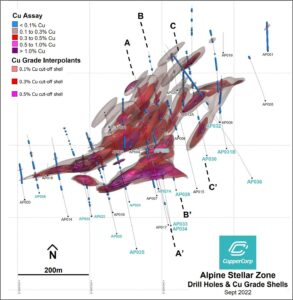
Figure 2. 3D plan map of the Alpine prospect showing completed drillholes, interpolated copper grade shells, and section lines.
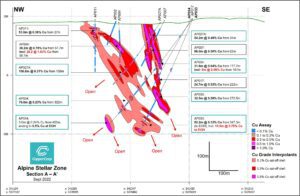
Figure 3. Drill section A-A’ (looking northeast) showing results from drill holes, including recent holes AP033 and AP034 at the Stellar zone, Alpine prospect. Significant intervals are reported as downhole lengths.

Figure 4. Photo drill core from hole AP034 (189.1-193.6m), part of the magnetite-pyrite-hematite-siderite hosted high-grade intercept, 5m @ 2.06% Cu from 187m.
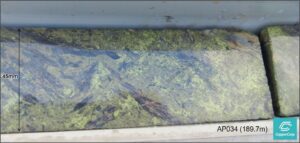
Figure 5. Close-up photo of chalcopyrite mineralization in drill core from hole AP034 (189.7m), part of the magnetite-pyrite-hematite-siderite hosted high-grade intercept, 5m @ 2.06% Cu from 187m.
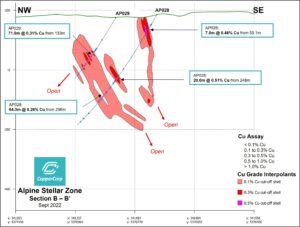
Figure 6. Drill section B-B’ (looking northeast) showing results from drill holes AP028 and AP029 at the Stellar zone, Alpine prospect. Significant intervals are reported as downhole lengths.
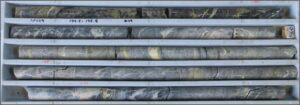
Figure 7. Photo of drill core from hole AP029 (194.2-198.8m), showing typical disseminated, blebby and vein style sulphide mineralization associated with silica-siderite alteration and veining.
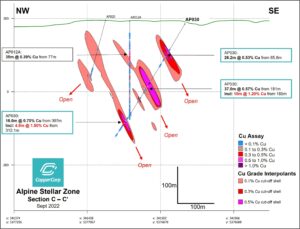
Figure 8. Drill section C-C’ (looking northeast) showing results from drill holes, including recent hole AP030 at the Stellar zone, Alpine prospect. Significant intervals are reported as downhole lengths.

Figure 9. Photo drill core from hole AP030 (189.2-193.8m), part of the magnetite-pyrite-hematite-siderite hosted high-grade intercept, 10m @ 1.20% Cu from 185m.
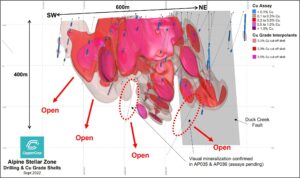
Figure 10. 3D view (looking north) of Alpine Stellar zone copper grade interpolation shells.

Figure 11. Photo of drill core from hole AP035 (245.4-248.9m), showing chalcopyrite mineralized magnetite-pyrite-hematite-siderite rock. Assays pending.
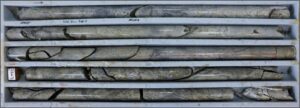
Figure 12. Photo of drill core from hole AP035 (406.3-410.7m), showing typical disseminated, blebby and vein style sulphide mineralization associated with silica-siderite alteration and veining. Assays pending.

Figure 13. Photo of drill core from hole AP036 (394.5-399.2), showing chalcopyrite mineralized massive magnetite-pyrite-hematite-siderite rock. Assays pending.

Figure 14. Photo of drill core from hole AP036 (399.2-403.8), showing chalcopyrite mineralized massive magnetite-pyrite-hematite-siderite rock. Assays pending.
Drill Hole Location Data
| Drillhole ID | Easting GDA94 | Northing GDA94 | mRL | Final Length (m) | Dip | Azimuth | Company |
| AP028 | 341440 | 5376710 | 185 | 459.9 | -60 | 340 | CopperCorp |
| AP029 | 341380 | 5376835 | 175 | 247 | -60 | 340 | CopperCorp |
| AP030 | 341525 | 5376815 | 185 | 364 | -60 | 340 | CopperCorp |
| AP031B | 341580 | 5376840 | 195 | 424 | -60 | 340 | CopperCorp |
| AP032 | 341560 | 5376920 | 196 | 328 | -57 | 310 | CopperCorp |
| AP033 | 341425 | 5376605 | 191 | 429.5 | -68 | 340 | CopperCorp |
| AP034 | 341425 | 5376605 | 191 | 460 | -53 | 340 | CopperCorp |
| AP035 | 341330 | 5376530 | 180 | 447.8 | -64 | 340 | CopperCorp |
| AP036 | 341650 | 5376750 | 193 | 600.1 | -65 | 300 | CopperCorp |
| AP037 | 340535 | 5376510 | 155 | In-progress | -56 | 340 | CopperCorp |
Table 1. Alpine prospect CopperCorp drill hole location and summary data (this news release).
Significant Mineralized Intervals (0.1% Cu cut-off)
| Prospect | Hole Number | From (m) | To (m) | Interval (m) | Cu (%) | Co (ppm) |
| Alpine | AP028 | 55.1 | 62.1 | 7 | 0.46 | 241 |
| And | 248 | 268 | 20 | 0.51 | 225 | |
| And | 296 | 360 | 64 | 0.26 | 73 | |
| Alpine | AP029 | 133 | 204 | 71 | 0.38 | 168 |
| Alpine | AP030 | 85.8 | 112 | 26.2 | 0.53 | 191 |
| And | 181 | 218 | 37 | 0.57 | 271 | |
| Including | 185 | 195 | 10 | 1.20 | 488 | |
| And | 240 | 248 | 8 | 0.25 | 172 | |
| And | 307 | 325 | 18 | 0.70 | 238 | |
| Including | 312.1 | 316.5 | 4.9 | 1.50 | 329 | |
| Alpine | AP031B | 227 | 234 | 7 | 0.44 | 258 |
| And | 386 | 390.1 | 4.1 | 0.34 | 183 | |
| Alpine | AP032 | 122 | 128 | 6 | 0.13 | 73 |
| And | 136.3 | 140 | 3.7 | 0.57 | 245 | |
| And | 228 | 254 | 26 | 0.11 | 40 | |
| Alpine | AP033 | 270.5 | 303 | 32.5 | 0.59 | 268 |
| And | 347.3 | 429.5 (EOH) | 82.2 | 0.33 | 102 | |
| Including | 419 | 429.5 (EOH) | 10.5 | 0.75 | 43 | |
| Alpine | AP034 | 177.7 | 209.3 | 31.6 | 0.64 | 200 |
| Including | 187 | 192 | 5.0 | 2.06 | 308 | |
| And | 258 | 267 | 9.0 | 0.42 | 209 | |
| And | 285 | 304 | 19.0 | 0.23 | 150 | |
| And | 322 | 398 | 76.0 | 0.23 | 88 | |
| And | 452 | 455 | 3.0 | 0.24 | 113 |
Table 2: Alpine Stellar zone prospect significant drillhole mineralized intercepts reported in this news release. Reported grades are calculated as down-hole length weighted averages. A 0.1% Cu lower cut-off grade is applied. Intercepts are downhole intervals.
Stephen Swatton, President and CEO of CopperCorp commented: “I am highly encouraged – with receipt of these latest assay results we can visualize the start of the build-out of an extensive copper mineralized zone where neither the depth nor the strike extent has been cut off by drilling to date. The geological district in the vicinity of Alpine is fertile as evidenced by many past and currently operating multicommodity mines (see Figure. 15) further adding to the appeal of discovering a possible new resource in a region which already has good infrastructure, abundant power, skilled labour and a supportive local government”
About the Alpine Prospect
The Alpine prospect was discovered by CRA Exploration in the early 1980’s after following up an airborne magnetic survey with gridding, ground magnetics, and soil geochemistry followed by two diamond drill holes in 1985. Stellar Resources drilled a further 19 holes between 2006 and 2008. The historical, wide-spaced drilling intersected significant IOCG-style copper mineralization, with significant intercepts including:
- AP004: 38.2m @ 0.79% Cu from 57.7m, including 28.2m @ 1.03 % Cu from 58.7m and 41.8m @ 0.3% Cu from 111.0m
- AP007: 86.0m @ 0.50% Cu from 62.0m
- AP008A: 41.0m @ 0.48% Cu from 29.8m
- AP017: 24.7m @ 0.52% Cu from 222.0m
Mineralization at Alpine is hosted in intensely deformed and metamorphosed amphibolites, mafic and pelitic schists, graphitic phyllites and carbonates belonging to the Bowry Formation of the Arthur Metamorphic Complex. Copper mineralization is associated with up to three sub-parallel magnetite-hematite-siderite-sulphide lenses in strongly silica-siderite altered chlorite schists. Mineralization consists mainly of chalcopyrite with lesser covellite and bornite. Additional chalcopyrite-pyrite breccia, vein and disseminated mineralization is hosted in silica-siderite altered and veined quartzites and schists adjacent to the ironstone lenses. Anomalous levels of cobalt is associated with the copper mineralization, typically averaging 200 to 300ppm Co and locally reaching up to 0.1% Co over short intervals.
The mineralization strikes east-northeast and dips steeply to the southeast, forming an interpreted fault-bound boudinage within the highly deformed schists of over 600m in strike length. Drilling completed to date indicates that the thickest part of the Alpine Stellar mineralized zone is over 100m in width, thinning to the west and thickening towards an interpreted faulted fold hinge in the east. The deposit remains open down dip and along strike to the west.
As previously reported3, results from recent geophysical modelling indicate that the drilled IOCG style mineralization at the Alpine Stellar zone is defined by coincident gravity and magnetic anomalies (see Figure 1). The model further indicates additional areas of high IOCG prospectivity indicated by coincident, partially coincident, or offset gravity and magnetic anomalies – the Alpine West (Figure 1) and Alpine North targets which the Company plans to drill test.
About the AMC Project
The AMC Project covers a total of 1,066 km2 along approximately 100 km of strike length and establishes CopperCorp as the dominant owner of prospective ground in the district. The rocks are Neoproterozoic-Cambrian age and comprise a regional-scale metamorphic structural deformation zone that is host to widespread magnetite-sulphide-silicate alteration and mineralization indicative of a large Iron Oxide Copper Gold (IOCG)-style system and includes the Savage River 498 Mt @ 46% DTR magnetite mine (owned by Grange Resources Limited)8 and CopperCorp’s Alpine copper prospect.
The Alpine prospect is located 30 km northwest of the local mining hub of Zeehan and within 5 km of two large-scale operating wind and hydro-electric renewable energy plants.
About CopperCorp
CopperCorp is a well-financed mineral exploration company with approximately C$7.7M in working capital as of September 14, 2022 targeting world class copper-gold discoveries in western Tasmania, Australia. The Company is currently undertaking infill and extension drilling and ground exploration programs at the Alpine Prospect where wide spaced historical drilling delineated IOCG-style mineralization over a 700m strike length2.

Figure 15. Location plan showing CopperCorp’s exploration licenses and project areas in western Tasmania, Australia.
Quality Assurance / Quality Control on Assay Results
Full information on historical exploration activities and results at the Alpine prospect and AMC Project are included in the Company’s Technical Report with an effective date of 18 April 20212.
CopperCorp’s diamond core drill holes are drilled at HQ and NQ core diameters using triple tube to maximize recovery. Core recovery is generally good in mineralized zones (95-100%) with poorer recoveries associated with brittle faulting on zone margins. Sample collection is supervised by CopperCorp geological staff. Mineralized zones are marked up for sampling by an experienced geologist. Half core is split by diamond saw on nominal 1.0m sample lengths while respecting geological contacts. Samples are bagged and ticketed prior to delivery by Company personnel to the ALS commercial laboratories in Burnie, Tasmania, for sample preparation. The half core samples are crushed to 80% passing 2mm, riffle split to 500g and then pulverized to pass 75um. Coarse duplicate sampling is conducted every 20 samples to assess variability of the coarse crush. Cu and multi-element assay is by 4-acid digest followed by ICP-MS at ALS laboratories by method ME-ICP61a. Au assay is by 30g fire assay at ALS laboratories by method Au-AA25. Certified reference materials (CRMs), blank and duplicate QAQC samples are included in sample submissions at 20 sample intervals. All QAQC samples were within acceptable limits (2 standard deviations for CRMs, duplicates <5%).
Mineralized Interval Calculations
Reported significant mineralized intervals in this news release (including for new and historical drillhole intervals) are calculated as down-hole length-weighted intercepts using a 0.1% Cu lower cut-off grade and generally carry a maximum internal dilution of 4m (except for AP028 and AP033 in which a maximum internal dilution of 10m was allowed within disseminated-vein style mineralization zones). The calculated intervals for historical drill holes reported in this news release may vary from previously reported interval calculations that used a cut-off grade of 0.3% Cu. The 0.1% Cu cut-off grade is considered to appropriately define the boundaries of copper mineralized zones at the Alpine prospect and provides for balanced reporting of drilling results during the exploration stage, enabling reporting of both low- and high-grade intercepts. No top-cut grade was applied. True widths of drill hole intercepts are yet to be determined; however, it is estimated that true widths are in the range of 70% to 95% of reported intervals.
Qualified Person
The Company’s disclosure of technical or scientific information related to the Alpine prospect and AMC Project in this news release was reviewed and approved by Sean Westbrook, VP Exploration for the Company. Mr. Westbrook is a Qualified Person as defined in National Instrument 43-101. This news release also contains information about adjacent properties on which the Company does not have an interest. Information sources regarding the adjacent properties are listed in the References section of this news release. The QP has been unable to verify the information on these adjacent properties and the information is not necessarily indicative to the mineralization on the properties that is the subject of this news release.
References
1Note: The Company cautions that with respect to any visible chalcopyrite (copper sulphide) or other visual mineralization indicators, such as the occurrence of other sulphide or oxide minerals, visual observations and estimates are uncertain in nature and should not be taken as a substitute for appropriate laboratory analysis. Laboratory assay results will be reported when they have been received, validated, and interpreted.
2Independent Technical Report on EL2/2018 Tasmania Australia. Prepared in accordance with Canadian National Instrument 43-101 Standards of Disclosure for Mineral Properties (NI 43-101). Effective date: 18 April 2021.
3CPER: TSXV News Release 27th April 2022.
4CPER: TSXV News Release 11th May 2022.
5CPER: TSXV News Release 8th June 2022.
6CPER: TSXV News Release 21st September 2022.
7Independent Technical Report on EL16/2018 Walford Peak (Skyline Project), Tasmania Australia. Prepared in accordance with Canadian National Instrument 43-101 Standards of Disclosure for Mineral Properties (NI 43-101). Effective date: 14 September 2022.
8Grange Resources Limited, 2021. Update to Savage River Mineral Resources and Ore Reserves, ASX Release 31 March 2021.
Contact:
Stephen Swatton
President, CEO & Director
Alexander Muir, CFA
Manager, Corporate Development & Investor Relations
604-970-8032
Additional information about CopperCorp can be found on its website: www.coppercorpinc.com and at www.sedar.com.
CAUTIONARY STATEMENT REGARDING FORWARD-LOOKING INFORMATION: This news release includes certain “forward-looking statements” under applicable Canadian securities legislation relating to drilling results, planned drilling, drilling and exploration programs, the interpretation of drilling results, the merits and potential of the Alpine West prospect and the Stellar zone, mineralization and the potential to expand the mineralization, the definition of higher grade mineralization zones, plans for future exploration and drilling and the timing of same, the use of 3D models to plan future drilling, the receipt of assay results and reporting of same, a maiden drill campaign at the Dora prospect within the Skyline Project, the merits of the Company’s mineral projects, funding of drilling programs and other plans of the Company. Forward-looking statements are statements that are not historical facts; they are generally, but not always, identified by the words “expects”, “plans”, “anticipates”, “believes”, “interpret”, “intends”, “estimates”, “projects”, “aims”, “suggests”, “often”, “target”, “future”, “likely”, “pending”, “potential”, “goal”, “objective”, “prospective”, “possibly”, “preliminary” and similar expressions, or that events or conditions “will”, “would”, “may”, “can”, “could” or “should” occur, or other statements, which, by their nature, refer to future events. The Company cautions that forward-looking statements are based on the beliefs, estimates and opinions of the Company’s management on the date the statements are made, and that such statements are subject to risks and uncertainties that may cause actual results, performance or developments to differ materially from those contained in the statements. Consequently, there can be no assurances that such statements will prove to be accurate and actual results and future events could differ materially from those anticipated in such statements. Accordingly, readers should not place undue reliance on forward-looking statements.
Factors that could cause future results to differ materially from those anticipated in forward-looking statements include risks associated with exploration and drilling; the timing and content of upcoming work programs; geological interpretations based on drilling that may change with more detailed information; possible accidents; the possibility that the Company may not be able to secure permitting and other governmental approvals necessary to carry out the Company’s plans; the risk that the Company will not be able to raise sufficient funds to carry out its business plans; the possibility that future exploration results will not be consistent with the Company’s expectations; increases in costs; environmental compliance and changes in environmental and other local legislation and regulation; interest rate and exchange rate fluctuations; changes in economic and political conditions; and other risks involved in the mineral exploration industry. The reader is urged to refer to the Company’s Management’s discussion and Analysis, publicly available through the Canadian Securities Administrators’ System for Electronic Document Analysis and Retrieval (SEDAR) at www.sedar.com for a more complete discussion of risk factors and their potential effects.
Forward-looking statements are based on a number of assumptions, including management’s assumptions about the following: the availability of financing for the Company’s exploration activities; operating and exploration costs; the Company’s ability to attract and retain skilled staff; timing of the receipt of necessary regulatory and governmental approvals; market competition; and general business and economic conditions. The Company disclaims any intention or obligation to update or revise any forward-looking statements, whether as a result of new information, future events or otherwise, except as required by law.
Neither TSX Venture Exchange nor its Regulation Service Provider (as that term is defined in policies of the TSX Venture Exchange) accepts responsibility for the adequacy or accuracy of this release.

